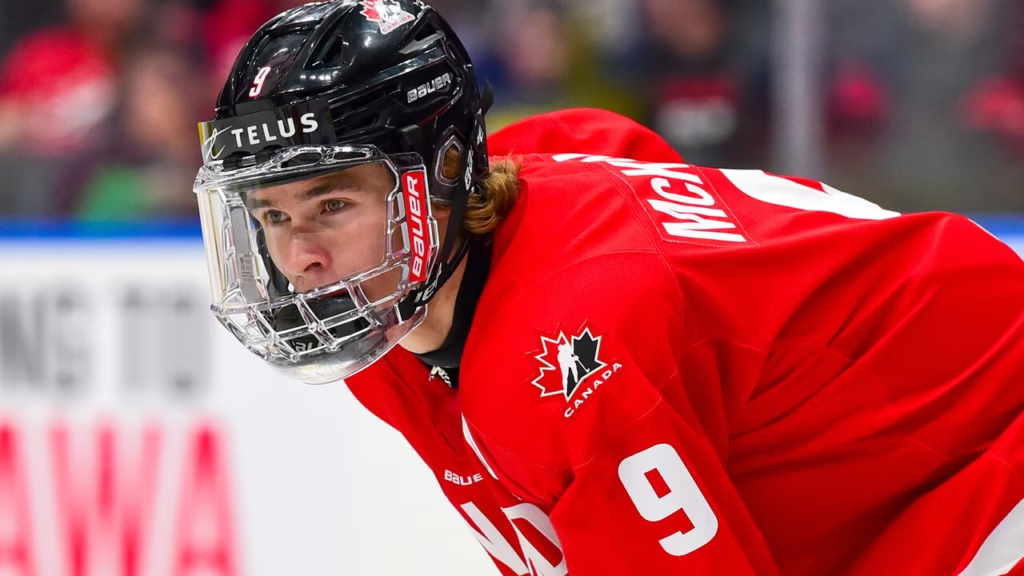By the end of this week, rookies will report and participate in pre-season tournaments, and by late next week NHL training camps will open around the league.
This sets in motion the official scouting calendar for both pro and amateur staffs from each NHL franchise. Pro scouts will be taking notes on rookies at the tournaments while amateur staffs are already busy collecting data on a new crop of prospects eligible for the draft next June.
After a brief hiatus, I’m back on the “tour,” preparing for in-depth analysis on prospects from a variety of backgrounds. I’m not comfortable rating draft-eligible players from top to bottom this early in the season, but it’s undeniable that some prospects have established more momentum than others. Most of that momentum is based upon the way they finished last season or performed at the Hlinka Gretzky Cup in August.
The 2026 NHL Draft class will be looked upon as a case study for years to come due to the fact some of the top players have left junior hockey to join the NCAA in the most important development year of their career to date. It’s going to be interesting monitoring how some highly ranked prospects adjust to playing fewer games and competing against older opponents in the NCAA.
Evaluating this class will take time to evolve, but the 2026 group of prospects has more skill at the top of the draft than 2025. The mix of size, skill, and competitiveness excites me and has a chance to provide a significant number of impactful NHL players to both lottery and non-lottery teams next June.
-
32 Thoughts: The Podcast
Hockey fans already know the name, but this is not the blog. From Sportsnet, 32 Thoughts: The Podcast with NHL Insider Elliotte Friedman and Kyle Bukauskas is a weekly deep dive into the biggest news and interviews from the hockey world.
Latest episode
Here’s a look at 10 draft-eligible prospects I will be tracking very closely to start the season:
Gavin McKenna, 6-feet, 165 pounds, left-shot winger, Penn State (NCAA)
An argument can be made that McKenna had nothing left to prove at the major junior level and his move from the Medicine Hat Tigers (WHL) to Penn State can be viewed as a natural progression for his overall development.
McKenna is the top-ranked prospect heading into the season for a reason. He’s coming off a year in which he produced 41 goals and 88 assists in 56 regular-season games, followed by nine goals and 29 assists in 16 playoff games. McKenna is a dynamic prospect who was also named the WHL and CHL player of the year for the 2024-25 season.
I’m confident projecting McKenna as a top-line scoring forward at the NHL level, but much more analysis goes into scouting prospects, including top-ranked ones in their draft year. I’m curious to see how he does while battling through more physically mature players in the NCAA and if he finds a role on one of the Nittany Lions’ penalty-killing units while fully anticipating the bulk of his ice time will come at even strength and the power play.
Keaton Verhoeff, 6-foot-3, 208 pounds, right-shot defenceman, North Dakota (NCAA)
Verhoeff is also making the jump to the NCAA after a solid first full season at the WHL level playing for Victoria. He’s a minute muncher who is deployed in all situations. Verhoeff uses his length as an advantage to open up shooting and passing lanes in the offensive zone as well as killing plays in the defensive zone, and has proven he can beat goalies from long range when quarterbacking the power play and ripping pucks on net. He produced 21 goals and 24 assists for the Royals and was a tidy plus-23.
Defencemen Verhoeff’s size, who play with presence on and off the puck in all three zones, provide immense value once they arrive in the NHL. Verhoeff could be a prospect who fast-tracks into the league after only one year at the college level, but he, too, will be challenged by older opponents at the NCAA level.
Viggo Bjorck, 5-foot-10, 172 pounds, right-shot winger, Djurgardens (Sweden J20)
There are two ways to look at how Bjorck approaches the game. Is he a calculating scoring threat who picks his spots and pounces quickly to produce offence? Or is he a dynamic player who simply possesses elevated hockey sense and skill compared to his opponents?
Teams will be monitoring if he has enough game to graduate to the SHL level (Sweden’s top pro league) this season and play to his identity. He produced 27 goals and 47 assists in only 42 games at the J20 level last season, but he’s not listed as a member of Djurgardens’ men’s roster to start the year despite his record-setting season in J20.
For me, Bjorck needs to take the play to the middle of the ice more often, but he has time on his side and a skill level that can’t be coached. He’s one of the most elite offensive players in this draft class.
Mathis Preston, 5-foot-11, 177 pounds, right-shot centre, Spokane Chiefs (WHL)
Preston’s combination of skill, speed and tenacity stands out to me. He produced four goals and three assists in five games at the Hlinka Gretzky Cup in August after contributing 23 goals and 22 assists last season in Spokane.
One of the things scouts monitor with prospects is their level of play when games get hard, for example in the playoffs. Preston produced nine goals and seven assists in 20 playoff games last spring for the Chiefs. He can be deployed in all situations and he’s a relentless competitor.
Here’s an example of his commitment defensively, leading to an offensive opportunity off the rush:
Ivar Stenberg, 5-foot-11, 179 pounds, left-shot winger, Frolunda (Sweden SHL)
Stenberg is a prospect who could challenge to go as high as second overall by the time the draft rolls around next June. He’s a goal-scoring forward who produced 26G-27A in only 27 games at the J20 level last season before being promoted to Frolunda’s men’s team in the SHL. He’s always been part of Sweden’s leadership group on the international stage and contributed 8G-5A at the U18 worlds last spring in Texas.
I appreciate the deception in Stenberg’s game. He takes stock of what’s in front of him off the rush and changes speeds accordingly when making plays. He’s also not shy about battling along the wall and in traffic to extend plays. He’s hard to defend offensively, has a very quick release and playmaking thought process, and is better than average tracking back defensively.
Xavier Villeneuve, 5-foot-10, 158 pounds, left-shot defenceman, Blainville-Boisbriand Armada (QMJHL)
Teams will monitor Villeneuve’s ability to defend and his overall approach when having to engage bigger opponents, but he’s uber-competitive and never gives up on a play. His most elite element is his ability to hit the offensive rush quickly, with and without the puck on his stick, and quarterback the power play. The bulk of his ice time comes at even strength and with the man advantage. Villeneuve produced 12G-50A for the Armada last season. He impressed me a great deal with his consistent impact, in relation to his element, at the U18 worlds in Texas last spring where he contributed 4G-4A for Team Canada.
Adam Novotny, 6-foot-1, 204 pounds, left-shot winger, Peterborough Petes (OHL)
Novotny is an intriguing prospect who’s very reliable with his approach and detail on and off the puck. When his group doesn’t have full control in the offensive zone, he makes sure he is above the play to assist defensively. He’s a threat off the rush when his team regroups and attacks through the neutral zone, and he gives opponents all they can handle out in front of their net and along the boards. He should thrive in the OHL. I expect Novotny to carry over the momentum from his time with Czechia’s U20 team this summer. He contributed 5G-4A in eight games before arriving in Peterborough.
Ryan Roobroeck, 6-foot-3, 210 pounds, left-shot centre, Niagara Ice Dogs (OHL)
The NHL values big, strong, goal-scoring forwards and Roobroeck fits the description. He produced 41G-46A in 64 regular-season games last year in Niagara and was very impressive for Team Canada at the U18 worlds where he pitched in 4G-5A in seven games.
As much as Roobroeck’s size is attractive, I’m not comfortable describing him as a power forward. He boxes out opponents efficiently and extends plays with his length, but he isn’t overpowering. He has time to further define his game, but his puck touch, and obvious results, stand out amongst his peer group in this draft class.
Tynan Lawrence, 6-feet, 185 pounds, left-shot centre, Muskegon Lumberjacks (USHL)
Lawrence is another name to keep a close eye on. He led the Lumberjacks in regular-season scoring last year (25G-29A) and took his game to another level when he was named the playoff MVP after leading Muskegon to a league championship and contributing 8G-10A.
Lawrence is a bit of an anomaly on this list. He has decided to return to Muskegon instead of moving to major junior or the NCAA this fall. I appreciate his loyalty. It speaks to his character. His skill offensively is his most attractive element, but he’s also trustworthy and competitive defensively.
Chase Reid, 6-foot-2, 185 pounds, right-shot defenceman, Soo Greyhounds (OHL)
I’m always intrigued by prospects who take a bit longer to develop compared to some of their peers and Reid fits that mould. The Greyhounds’ scouting staff should be proud of what they have found in Reid. He wasn’t drafted until the seventh round (125th overall) at the 2023 OHL Priority Selection. Reid started last season skating for Bismarck in the NAHL before arriving in the Soo before Christmas.
Reid established himself as a two-way defenceman last year. He’s confident with the puck on his stick, aggressive extending plays in the offensive zone, and agile moving east-to-west to open up shooting lanes. He ended his rookie campaign with 7G-33A in 39 games. I get the feeling Reid might just be scraping the surface of his overall ability.
Discover more from 6up.net
Subscribe to get the latest posts sent to your email.


